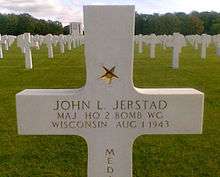Ardennes American Cemetery and Memorial
| Ardennes American Cemetery and Memorial | |
|---|---|
| American Battle Monuments Commission | |
|
View of the memorial, with headstones visible behind. | |
| Used for those deceased 1941–1945 | |
| Established | 8 February 1945 |
| Location |
50°32′51″N 5°27′56″E / 50.54750°N 5.46556°ECoordinates: 50°32′51″N 5°27′56″E / 50.54750°N 5.46556°E near Neupré, Wallonia, Belgium |
| Designed by |
Reinhard, Hofmeister & Walquist Richard K. Webel (landscaping) |
| Total burials | 5,329 |
| Unknown burials | 792 |
| Statistics source: ABMC Ardennes website | |
The Ardennes American Cemetery and Memorial is home to the graves of 5,329 members of the United States military who died in World War II. It is one of fourteen cemeteries for American World War II dead on foreign soil, and is administered by the American Battle Monuments Commission. The ninety and a half acre cemetery and memorial is located in Neuville-en-Condroz, near the southeast edge of Neupré, Wallonia, Belgium. It is one of three American war cemeteries in Belgium, the other two being at Flanders Field and Henri-Chapelle.
Layout and memorial
The Ardennes American Cemetery is generally rectangular in shape. Its grave plots are arranged in the form of a Greek cross separated by two broad intersecting paths. At the east end of the traverse path is a bronze figure symbolizing American youth, designed by sculptor C. Paul Jennewein. The cemetery is surrounded on all sides by stands of trees.
An approach drive leads to the memorial, a rectangular structure bearing on its south facade a massive American eagle with three figures symbolizing Justice, Liberty, and Truth and thirteen stars representing the United States. This facade was designed by C. Paul Jennewein. The facade on the far (north) end, which overlooks the burial area, bears the insignia in mosaic of the major United States units which operated in northwest Europe in World War II. Along the outside of the memorial are the "Tablets of the Missing", granite slabs on which are inscribed the names of 462 American missing (15 Navy and 447 Army and Army Air Forces) who gave their lives in the service of their country, but whose remains were never recovered or identified. Within the memorial are a chapel, three large wall maps composed of inlaid marble, marble panels depicting combat and supply activities and other ornamental features.
History
The site of the cemetery was liberated from Nazi control by the U.S. 1st Infantry Division on 8 September 1944. A temporary cemetery was established on the site on 8 February 1945. After the war, the Ardennes site was designated a permanent cemetery, becoming one of fourteen permanent cemeteries for American World War II dead on foreign soil. All temporary cemeteries were disestablished by the U.S. Army, and the bodies of those whose next of kin requested permanent interment overseas were moved to one of the fourteen permanent cemeteries.
The American Battle Monuments Commission (ABMC) oversaw the design and construction of the site. Architects Reinhard, Hofmeister & Walquist of New York City were hired to design the cemetery and memorial, while the landscaping was designed by Richard K. Webel of Roslyn, New York. Construction of the cemetery and memorial was completed in 1962.
The Ardennes American Cemetery served as the location of the Central Identification Point for the Graves Registration Service (now known as Mortuary Affairs) of the Army Quartermaster Corps during much of the life of the Service. The Graves Registration Service interred the dead at the Ardennes cemetery in the distinctive grave pattern proposed by the architect and approved by the ABMC. When the interment program was completed the cemetery was turned over to the ABMC for maintenance and administration.
Interments

Many of the 5,329 people interred at the Ardennes American Cemetery died during Nazi Germany's final major offensive in the west, the Battle of the Bulge. They include some service troops who were fighting as infantry. Others died in the advance to the Rhine and across Germany, and in the strategic bombardment of Europe. Three-fifths of those buried in the cemetery were airmen.
The dead came from almost every state in the Union as well as from Washington, D.C., Canada, Denmark, England, France, Germany, Ireland, the Philippines, and the British West Indies. Seven hundred seventy-seven of the headstones mark the graves of 792 unidentified bodies. Among the headstones are eleven instances in which two brothers are buried side by side. There are also three cases in which two identified airmen are buried in single graves.
Buried in the cemetery are two Medal of Honor recipients: Technical Sergeant Charles F. Carey, Jr., and Major John L. Jerstad. Their graves are marked by special headstones with gold lettering. A third Medal of Honor recipient, Captain Darrell R. Lindsey, is listed on the Tablets of the Missing cenotaph. Also buried at Ardennes is Bert Stiles, a fighter pilot who wrote a posthumously-published memoir of his aerial combat experiences.
The cemetery is closed to future interments, with exceptions made for recently recovered remains of American World War II dead. In 1992, the remains of American war dead were discovered in a forest east of Elsenborn, Belgium. Through DNA testing, one set of remains was identified as Sgt. John T. Puckett of Wichita, Kansas, who had been listed as Missing in Action during the Battle of the Bulge. Puckett's family requested he be interred in the Ardennes cemetery; his burial there took place on 18 June 2005.[1]
Notes
- ↑ "News Release No. 617-05, WWII Missing in Action Soldiers Identified". U.S. Department of Defense. 2005-06-17. Archived from the original on 2006-08-27. Retrieved 2006-08-29.
References
- "Ardennes American Cemetery and Memorial". American Battle Monuments Commission. Archived from the original on 16 July 2006. Retrieved 2006-08-02.
Further reading
- Sledge, Michael (2005). Soldier Dead: How We Recover, Identify, Bury, and Honor Our Military Fallen. New York: Columbia University Press. ISBN 9780231509374. OCLC 60527603.
